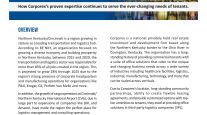FMCSA to Increase Focus on Driver Health
This story appears in the Oct. 25 print edition of Transport Topics.
PHOENIX — The Federal Motor Carrier Safety Administration is looking ahead to a number of rules focused on driver health and fitness in the next year or two, after the agency completes its spate of mandatory regulations, Administrator Anne Ferro said last week.
After regulations related to driver hours are completed, she said, there are several “driver health and driver fitness rules . . . on our plate.”
“It’s a mix of balancing our mandates, lawsuits and our safety priorities” in the regulatory process, Ferro said during an Oct. 19 interview with Transport Topics.
She cited an overdue rule finishing a list of qualified medical examiners and added there has “been a long wait for anything on sleep apnea, and those are all in the 2011-to-2012 range.”
In addition, Ferro said, the agency’s unified carrier registration system, which would create a single point of contact for fleets registering for interstate authority, is “probably about six or seven months away” from the first steps in the rulemaking process.
FMCSA also is nearing completion of a rule updating a commercial driver license and learner’s permit rule, which could be finished “in the next three months,” she said.
The agency also expects to issue its entry-level driver training regulation, which has been ordered by a federal court, sometime in 2011.
FMCSA is currently working on two driver-hours rules that a federal court has ordered the agency to finish by the end of the year: a driver hours-of-service revision and a rule listing the documents fleets must keep to verify those hours.
The HOS rule is now in review by the White House Office of Management and Budget and is due out in the next few weeks. The “supporting documents” rule is expected to include a mandate for electronic onboard recorders and must be published by year-end.
Beyond those two significant rules, the agency is also in the finishing stages of rolling out CSA — its new safety monitoring system — including making public most of a carrier’s safety record and issuing a rule early next year updating the way fleets’ fitness is determined.
Getting through these regulations, she said, is part of the agency’s plan to create “a full five-year schedule, similar to NHTSA,” that lays out what the agency is planning to do.
“We want to be very transparent about what are our long-term plans and short-term plans,” she said.
Ferro also said that, beyond the regulatory environment, the agency is working on new ways to develop technology to improve safety and enforcement.
Citing FMCSA’s technology showcase earlier this month in Tennessee, Ferro said there are items, “like performance-based brake testing,” that could be ready in the very near future to deploy widely in order to improve the testing.
Jeff Loftus, chief of FMCSA’s technology division, also cited the wireless roadside inspection program that is being pilot-tested as a promising application of technology.
“We’re testing the ability to use existing onboard technologies . . . as well as very low-cost solutions that involve no technology on a truck, just an Internet connection on a truck,” he said during the interview with Ferro. “We’re looking at various ways to identify the driver and assess the driver’s compliance with hours-of-service.”
Loftus said the program is “not a citation-issuing program. . . . We’re not going to issue fines; it is a measurement program.”
In another use of technology, Ferro answered questions about how the agency tracks drivers, after some reports had said that FMCSA was putting worrisome drivers on a list.
“We do not have a driver list,” she said. “We have several different programs which allow us to do what we’re supposed to do, which is focus on driver or operator fitness.”
Those programs range from the pre-employment screening program for fleets to CSA, as well as databases of “egregious violations,” such as operating without a CDL or operating in violation of an out-of-service order, she said.



